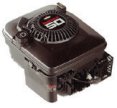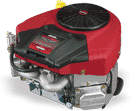Identifying Your engine
Briggs and Stratton engines are generally called by their crankshaft alignment, cylinder count and valve configuration.
They also have a unique Model, type and code numbering system which identifies each engine.
| When you have finished with this help page, click to close this window |
|
|
|
General Description
Crankshaft Alignment
Crankshaft alignment is either VERTICAL or HORIZONTAL.
Vertical crankshaft engines have the crankshaft running vertically through the engine and extending out of the bottom. The piston and cylinder
are horizontal with the flywheel on top of the engine. These are the engines fitted to rotary lawnmowers.
Horizontal crankshaft engines have the crankshaft running horizontally through the engine and extending through the side.The piston and
cylinder run vertically up and down with the flywheel on the side of the engine. Cylinder Count
This is the number and configuration of the cylinders and pistons in the engine. This will be either SINGLE CYLINDER, TWIN CYLINDER('V' or opposed), THREE CYLINDER etc. Valve Configuration
The type of valve set up is also noted. Either OVERHEAD VALVE or SIDE VALVE(also called L-HEAD).
|
Briggs and Stratton Model, Type and Code numbers
Briggs and Stratton engines are identified with a MODEL, TYPE and CODE number system and take the form of the example below.
- The MODEL number is either 5 or 6 digits which may contain letters
- The TYPE number is 4 digits followed by a trim extension of 2 digits. Letters may be used in the extension
- The CODE number is the machine's serial number. The first two digits are the Year of manufacture, the next two the Month
and the 5th and 6th are the Day (the example above was made on 7th July 1999)
The numbers can be in a variety of locations depending upon the engine but are generally to be found either:-
Stamped into the front, top or side of the main cowling.
These sometimes need corrosion removed or plastic
cowlings lifted slightly or air filter removed to see. |
 |
Stamped into a plate over the exhaust or a bracket
in front of the carburettor. |
 |
Etched into the crankcase side behind the carburettor
or behind the exhaust. |
 |
Etched or stamped into the edge of a rocker cover.
These sometimes need corrosion cleaning off to see. |
 |
Etched into an aluminium plate riveted to the cowling.
These can sometime be forced off. If this has happened,
there will be two small pulled out rivet holes. |
 |
| Etched into the crankcase at the rear. |
 |
| Etched into the plastic fuel tank (Quantum Mk1 Model 100708) |
 |
Please be aware that engines of unknown history may have had their cover etc. swapped from another. If there are signs that this may have happened, please let us know.









